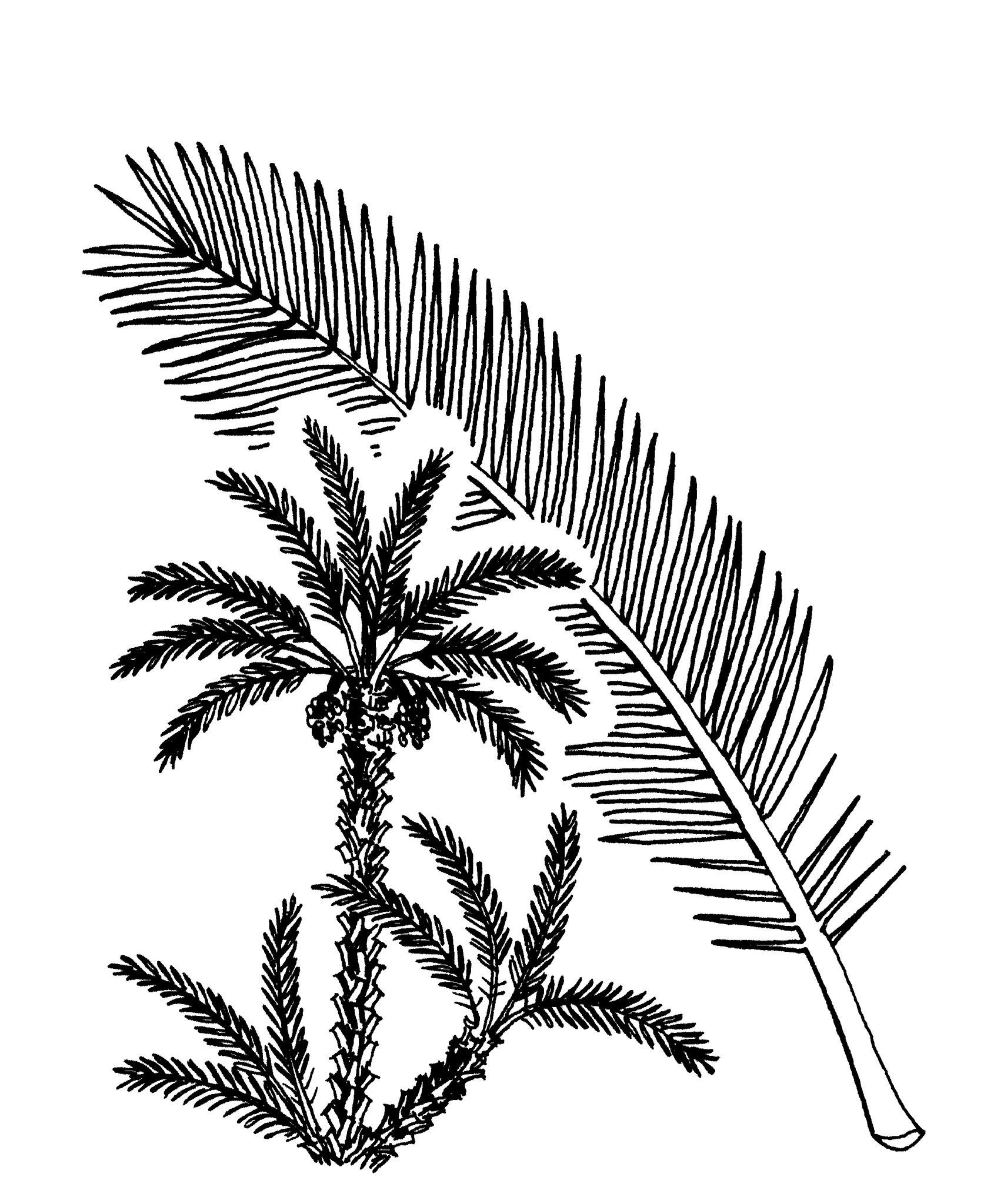
Sturdy suckering (rarely solitary) palm. Trunk to 20 m tall, stout, grey, covered with woody leaf bases. Leaves arching in a rounded crown, ash grey. Leaflets arranged in a flat plane, covered with a white powder. Flowers cream to yellowish, in large arching panicles to 3 m long. Fruit about 6 cm long, yellowish to brown, the seed flattened, pointed at the ends.
North Africa
Unknown in the wild but one of the oldest recorded cultivated plants with many old plants growing around oases in northern Africa. Grown as a commercial crop for its succulent edible fruit in semi-arid areas with a hot dry climate. Widely planted in tropical, subtropical and temperate regions but infrequently grown as an ornamental in Australia. Many early date plantations in Australia were abandoned in the early 1900s. Trees may be seen through central Australia where, to prevent uncontrolled spread, only males have been preserved for their heritage value. Some of the productive females were transplanted to what is now The Date Farm at Alice Springs which was established in 1950. The Azri, Aridgold and J. & T. Luedis plantations are also in Alice Springs or nearby. There is a plantation at Katherine (CSIRO) and in Queensland there is the Date Grove. Commercial propagation is by offshoots from mature plants and they take about 5 years to bear fruit. After pollination, fruit can be produced in abut 5-6 months with a single tree yielding to about 150 kg of dates. Trees may live for up to 200 years during which about 40 years are commercially viable. Cultivars include: 'Medjool' a popular Middle Eastern rich-flavoured date originating from Morocco; 'Zahidi' an Iraqi date with fibrous caramel-tasting flesh. Other overseas cultivars include 'Deglet Noor', 'Barhee' and 'Thoory'. Australian cultivars include 'Monica' named after the female occupant of the house it was obtained from; 'Red Bungalow' a reddish date grown in the bungalow in Alice Springs where children of the stolen generation were housed, and 'Undoolya' a date originating from an Alice Springs cattle station. Plants grow successfully in cold temperate regions and in coastal districts but in such climates they rarely produce flowers and do not fruit.
Commercially clonal propagation is by transplanting of offshoots; seed is unpredictable. Tissue culture is being used more.
Tall suckering palm with a stout grey trunk and rounded crown of ash-grey feather-shaped leaves with the leaflets arranged in a flat plane.
NSW: Sydney (Royal Botanic Garden Sydney); Albury (Albury Botanic Gardens). Vic: Melbourne (Royal Botanic Gardens Victoria (Melbourne Gardens) - in the Princes Lawn is a non-clustering tree labelled P. dactylifera which was grown in 1839 in the Collins St garden of Dr Godfrey Howitt a member of the first Committee of Management for the Gardens appointed by Governor La Trobe. The palm was transplanted to the Gardens as a gift in the 1880s and is now probably the oldest surviving cultivated tree in Victoria).
P. sylvestris Roxb., Silver Date Palm (Sugar Date Palm) from India is a tall solitary palm but is closely related to P. dactylifera and considered by some botanists to be the original date palm from which the commercial date has been derived by a process of selection. Trunk to 10 m tall, grey, covered with woody leaf bases. Leaves arching in a rounded crown, greyish-green, waxy blue or yellowish-green, often with a hanging skirt of dead leaves. Leaflets arranged in several planes to appear plumose. Flowers cream, crowded in arching panicles to about 3 m long. Fruit about 2.5 cm long, yellow when ripe. It grows naturally in grassland and woodland, usually in extensive stands. A very hardy palm which is grown on a limited scale in tropical, subtropical and temperate regions. In India the flower stalks are tapped for sap which is boiled to produce date sugar. Recognised by the slender grey woody trunk and a rounded crown of grey-green, waxy blue or yellowish-green feather-shaped leaves with the leaflets arranged plumosely in several planes. In Victoria specimens can be seen at Ararat (Alexandra Park) and Melbourne (Royal Botanic Gardens Victoria (Melbourne Gardens)) and in NSW at Sydney (Royal Botanic Garden Sydney).
P. theophrasti Greuter, the Cretan Date Palm from Crete, Greece and Turkey is occasionally grown; it is generally similar in appearance to P. dactylifera but shorter, with erect inflorescences and small fruit which lacks flesh. In nature it forms small colonies on rocky slopes in semi-arid areas. A very hardy, drought resistant palm.
Source: (2005). Arecaceae. In: . Horticultural Flora of South-eastern Australia. Volume 5. Flowering plants. Monocotyledons. The identification of garden and cultivated plants. University of New South Wales Press.
